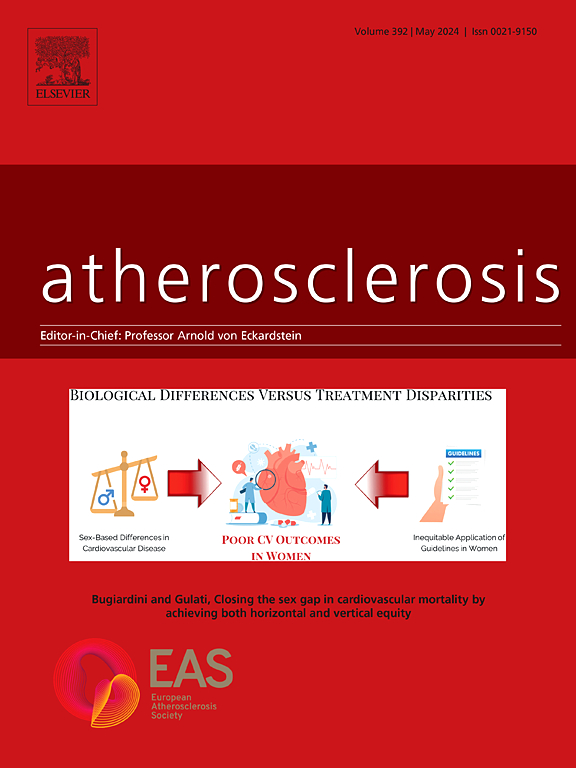在二级预防队列中,白细胞介素-6改变脂蛋白(a)和氧化磷脂相关的心血管疾病风险
IF 4.9
2区 医学
Q1 CARDIAC & CARDIOVASCULAR SYSTEMS
引用次数: 0
摘要
背景和目的需要有效的工具来分层和改变与脂蛋白(a)升高[Lp(a)]和氧化磷脂(OxPL)相关的心血管风险。本分析的目的是探讨在二级预防队列中,低级别炎症对Lp(a)-和oxpl相关风险的调节作用。方法在低剂量秋水仙碱2试验的安慰剂组中测定与载脂蛋白(a) (OxPL-apo[a])和载脂蛋白B (OxPL- apob)相关的Lp(a)、OxPL-apo[a]的水平。患者年龄在35岁至82岁之间,已确诊为慢性冠状动脉综合征(CCS),在随机分组前至少6个月临床稳定。结果是自发性心肌梗死、缺血性卒中或缺血驱动的冠状动脉血运重建的复合终点的发生率,使用Cox回归模型按生物标志物水平分层。结果Lp(a)与IL-6和lt之间存在显著的相互作用;在复合终点,IL-6≥3.2 ng/L(中位数)(HR 0.90;95% CI 0.78-1.03 vs HR 1.18;95% CI 1.01 ~ 1.39, p交互作用= 0.01)。2 mg/L hsCRP患者的Lp(a)水平未发现相互作用(HR 1.00;95% CI 0.89-1.14)与hsCRP≥2 mg/L (HR 1.04;95% CI 0.86-1.25, p交互作用= 0.79)。与Lp(a)水平一致,在IL-6复合终点,OxPL-apo(a)和OxPL-apoB水平之间观察到显著的相互作用(Pinteraction<;分别为0.01和0.03),但在hsCRP中没有。结论在CCS患者中,Lp(a)、OxPL-apo(a)和OxPL-apoB相关心血管风险仅与IL-6升高相关,而与hsCRP水平升高无关。本文章由计算机程序翻译,如有差异,请以英文原文为准。

Interleukin-6 modifies Lipoprotein(a) and oxidized phospholipids associated cardiovascular disease risk in a secondary prevention cohort
Background and aims
There is a need for effective tools to stratify and modify cardiovascular risk associated with elevated lipoprotein(a) [Lp(a)] and oxidized phospholipids (OxPL). The objective of this analysis was to explore the modifying effects of low-grade inflammation on Lp(a)- and OxPL-associated risk in a secondary prevention cohort.
Methods
Levels of Lp(a), OxPL associated with apolipoprotein(a) (OxPL-apo[a]) and apolipoprotein B (OxPL-apoB) were determined in the placebo-arm of the low-dose colchicine 2 trial. Patients were between 35 and 82 years, had established chronic coronary syndrome (CCS), and were clinically stable for at least six months prior to randomization. The outcome was the incidence of the composite endpoint of spontaneous myocardial infarction, ischemic stroke, or ischemia-driven coronary revascularization stratified by biomarker levels using a Cox regression model.
Results
There was a significant interaction between Lp(a) and IL-6 <3.2 ng/L (median) and IL-6 ≥3.2 ng/L for the composite endpoint (HR 0.90; 95 %CI 0.78–1.03 vs HR 1.18; 95 %CI 1.01–1.39, Pinteraction = 0.01). No interaction was found for Lp(a) levels in participants with hsCRP <2 mg/L (HR 1.00; 95 %CI 0.89–1.14) versus those with hsCRP ≥2 mg/L (HR 1.04; 95 %CI 0.86–1.25, Pinteraction = 0.79). In line with Lp(a) levels, significant interaction was observed between OxPL-apo(a) as well as OxPL-apoB levels for the composite endpoint with IL-6 (Pinteraction<0.01 and 0.03, respectively), but not for hsCRP.
Conclusions
In patients with CCS, Lp(a), OxPL-apo(a) and OxPL-apoB associated cardiovascular risk was only pertinent in those with elevated IL-6 but not hsCRP levels.
求助全文
通过发布文献求助,成功后即可免费获取论文全文。
去求助
来源期刊

Atherosclerosis
医学-外周血管病
CiteScore
9.80
自引率
3.80%
发文量
1269
审稿时长
36 days
期刊介绍:
Atherosclerosis has an open access mirror journal Atherosclerosis: X, sharing the same aims and scope, editorial team, submission system and rigorous peer review.
Atherosclerosis brings together, from all sources, papers concerned with investigation on atherosclerosis, its risk factors and clinical manifestations. Atherosclerosis covers basic and translational, clinical and population research approaches to arterial and vascular biology and disease, as well as their risk factors including: disturbances of lipid and lipoprotein metabolism, diabetes and hypertension, thrombosis, and inflammation. The Editors are interested in original or review papers dealing with the pathogenesis, environmental, genetic and epigenetic basis, diagnosis or treatment of atherosclerosis and related diseases as well as their risk factors.
 求助内容:
求助内容: 应助结果提醒方式:
应助结果提醒方式:


